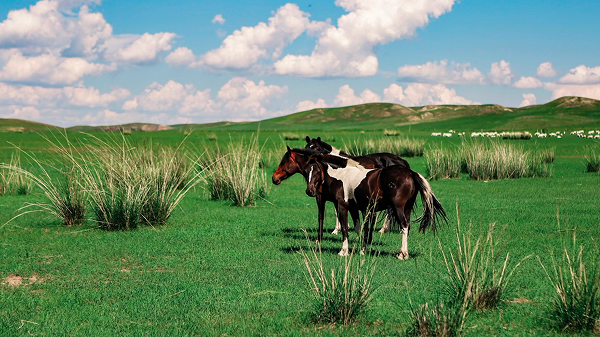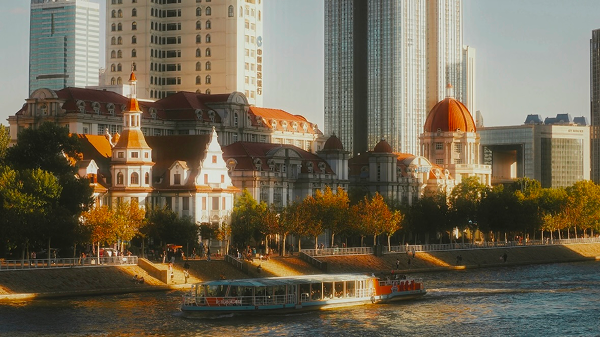Have you ever wondered where the grasslands of China are located—those endless green horizons dotted with yurts, horses, and blue skies? Welcome to Inner Mongolia, a place where the name itself means “Eternal Fire”.

Stretching more than 2,400 kilometers across northern China, Inner Mongolia is a land of sweeping grasslands, golden deserts, and a living culture that bridges ancient nomadism and modern life.
This Inner Mongolia travel guide will take you from the Hulunbuir Grassland to the Badain Jaran Desert, from sacred monasteries to the Genghis Khan Tomb, revealing the stories and spirit that make this region unlike anywhere else.
A Land Born of Fire and Sky
1. The spark of eternal fire
The name “Mongolia” comes from a Mongolian phrase meaning Eternal Fire—a symbol of endurance, purity, and skyward faith.
But before the horseback empires, Mongolian ancestors farmed river valleys during the Hongshan Culture (4700–2900 BCE).
By the Warring States period, northern tribes like Linhu and Loufan clashed with the State of Zhao. King Wuling of Zhao—won, by wise—reformed his army in “Hu-style cavalry and clothing.” It was here, near modern-day Hohhot, that China’s first cavalry warfare was born.

2. Religion and Belief: From Sky Gods to Dalai Lamas
For thousands of years, Mongolians followed Shamanism, worshiping Tengri, the sky god. After the An Lushan Rebellion in the Tang dynasty, western Inner Mongolia was influenced by the Uyghur Khaganate, which practiced Manichaeism—a blend of Zoroastrianism, Christianity, and Buddhism from ancient Persia.
In 947 AD, the Khitan people established the Liao Dynasty and built their capital in present-day Chifeng—marking the first official capital in the Mongolian grasslands.
Then came the moment that changed world history.

3. The Rise of Genghis Khan and the Mongol Empire
In 1206, Temujin united the tribes of the steppe and became Genghis Khan, founding the Mongol Empire.
Under his leadership, and later his grandson Kublai Khan, the empire stretched from the Pacific to Eastern Europe. Beijing (then Dadu) became the capital of the Yuan Dynasty, linking the Mongol grasslands to the world.
By this time, Mongolian nobles had adopted Tibetan Buddhism. Kublai Khan honored the 3rd Sakya lama Phagpa as his imperial teacher. In the 16th century, the Mongols formally embraced Gelugpa (Yellow Hat) Tibetan Buddhism. One of the most famous lamas in history, the 4th Dalai Lama—Yonten Gyatso, was the only Dalai Lama of Mongolian descent.

4. Modern Inner Mongolia: From Clans to Counties
During the Qing Dynasty, Mongolia adopted the “League and Banner” system—still visible today.
Inner Mongolia now has three major Leagues:
- Xing’an League – homeland of nomadic tribes and forested plains.
- Xilin Gol League – heart of Mongolian horse culture and home to the Xilamuren Grassland.
- Alxa League – vast desert territory where the Badain Jaran Desert shimmers with hidden lakes.

The Eternal Land of Sky and Stone
Inner Mongolia stretches over 2,400 kilometers east to west, covering 1.18 million square kilometers, nearly 12% of China’s total land area.
- Grasslands: 86 million hectares—one-quarter of China’s total.
- Forests: Over 408 million mu, the largest in the country.
- Elevation: Averaging 1,000 meters above sea level, peaking at Helan Mountain’s 3,556 meters.
- Border: 4,200 kilometers shared with Russia.

The region is a canvas of extremes:
- The Hulunbuir Grassland, China’s largest and the world’s third largest, often called “the Pearl of the Steppe.”
- The Deserts of Inner Mongolia—Badain Jaran, Tengger, Ulan Buh, and Kubuqi—offer surreal sand dunes and mirror lakes.
- The Daxing’anling Mountains define the eastern ecological zone.
The region’s wealth lies not only in its beauty but its minerals:
rare earth metals, coal, zinc, and lead—with Baotou known as “the Rare Earth Capital of the World.”
Chifeng produces the famed Balin Stone, prized for its translucent smoothness—like the skin of an infant—perfect for carving imperial seals.
Culture, Literature, and Spirit
Mongolia’s literary and oral traditions run as deep as its rivers.
The epic “Geser”—often compared to The Divine Comedy—sings of heroism and cosmic destiny.
The first historical Mongolian novel, “Ubashi Hong Taiji,” tells of tribal wars and tragic valor in the 16th century.
To Visit the Eternal Flame: What to Know and Feel
If you’re invited into a Mongolian yurt (ger), remember these customs:
- Never sit in the northwest corner—it’s reserved for the elder or the host.
- When offered sheep head or tail, accept—it’s the highest form of hospitality.
- Fried rice (炒米) and milk tea are staples of every guest table.
- If you’re lucky, you’ll be invited to join an Andai Dance, wrapped in rhythm and laughter.
- Mongols revere white—purity and blessing. A local may present you with a hada (white silk scarf) to honor your visit.
During summer, travel to the Huanghuagou Scenic Area to watch the open-air play “Aobao Xianghui (Meeting at the Sacred Mound)”;
or to Xiangshawan Desert, where the musical show “Ordos Wedding” brings Mongolian traditions to life beneath the dunes.
Come in festival season—especially during Naadam, when you can witness horse racing, wrestling, and archery—and hear Long Song (长调) and Khoomei throat singing, both listed by UNESCO as Intangible Cultural Heritage of Humanity.
The Genghis Khan Mausoleum & Mausoleum of Wang Zhaojun
The Genghis Khan Mausoleum (成吉思汗陵) stands near the Black River—a spiritual memorial to the great conqueror whose true burial site remains a mystery. Some say new archaeological digs may have found traces of his final resting place, sparking interest in the phrase “Genghis Khan tomb found.”

And south of Hohhot, by the Black River, you can pay respects at the Mausoleum of Wang Zhaojun, one of China’s Four Great Beauties—who married into the Xiongnu kingdom for peace. Her grave, called the Green Tomb, is said to stay verdant even through winter snow.

Subscribe for More Hidden Stories of China
From deserts to dynasties, from temples to teahouses—Bridge to Locals brings you closer to the heart of China.
Subscribe for authentic travel stories, cultural insights, and connections with locals across the Middle Kingdom.







Leave a comment
This site is protected by hCaptcha and the hCaptcha Privacy Policy and Terms of Service apply.